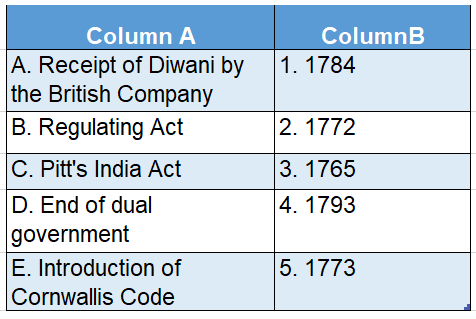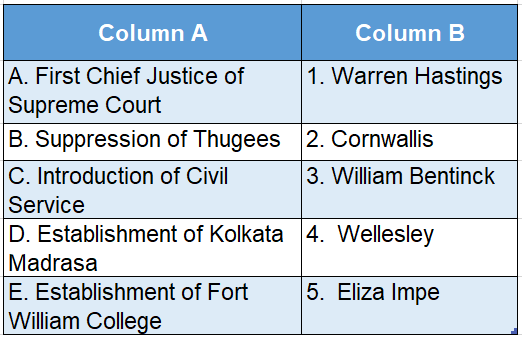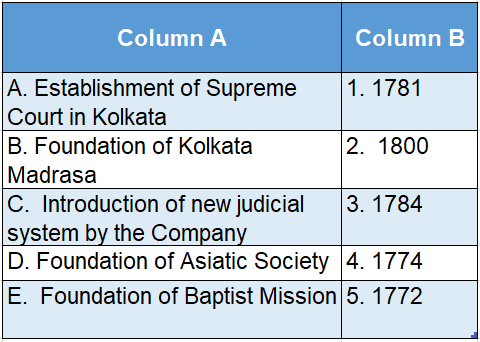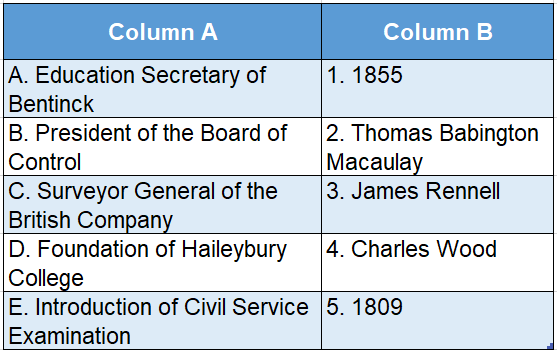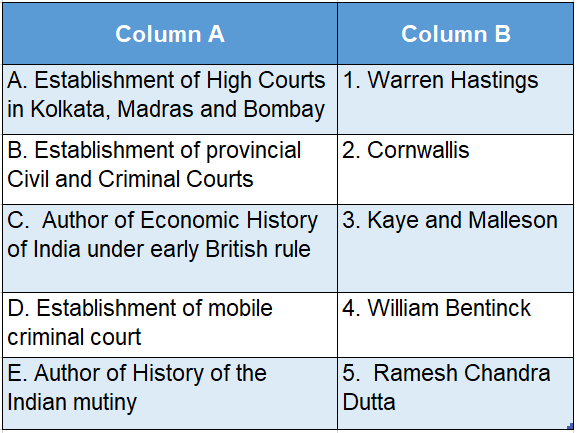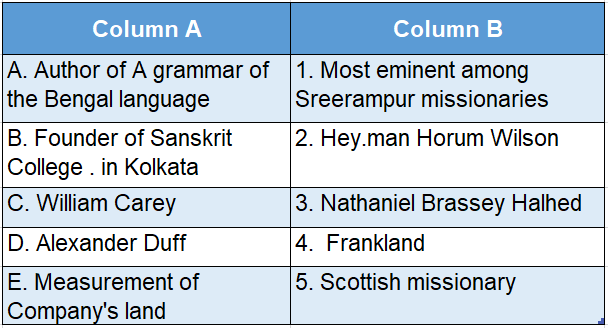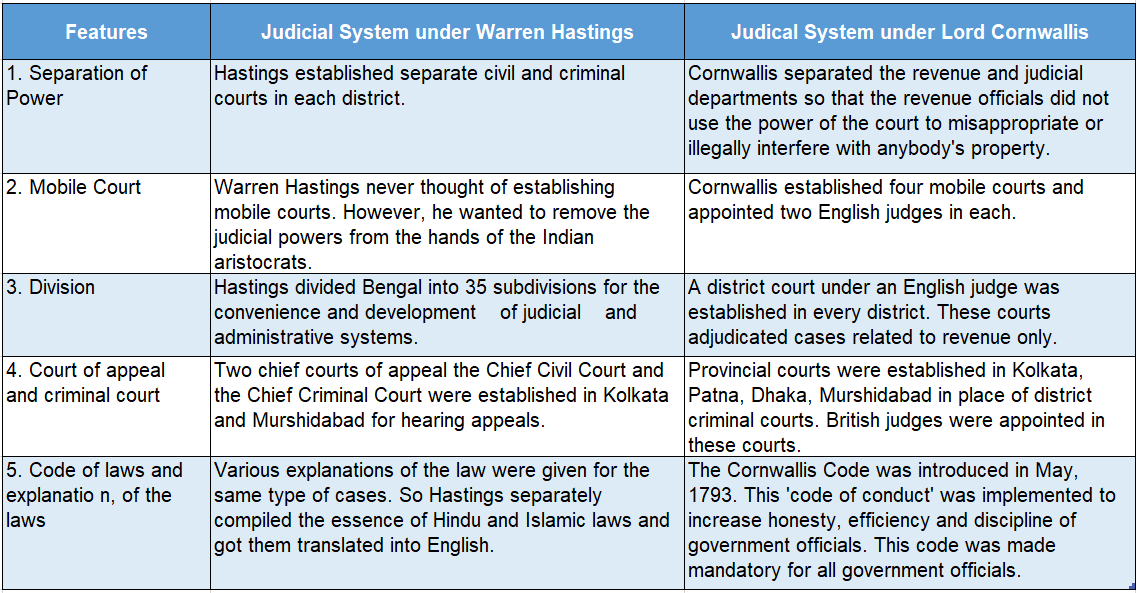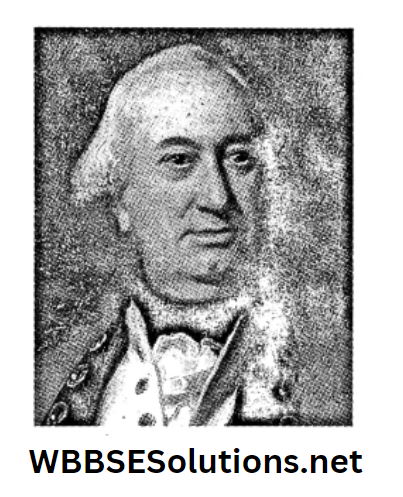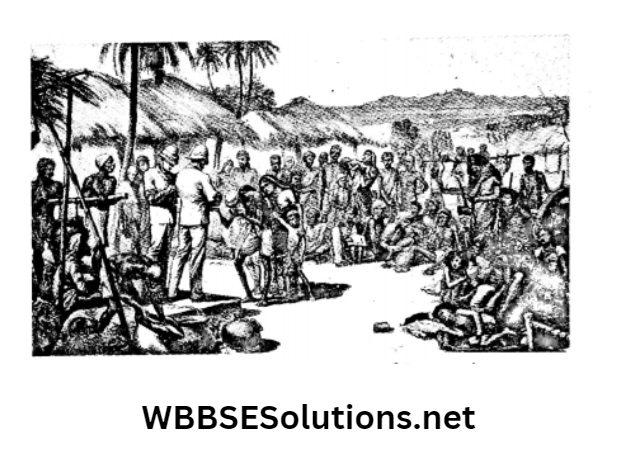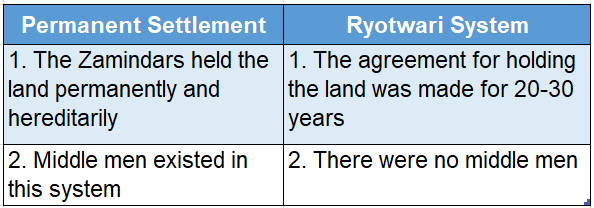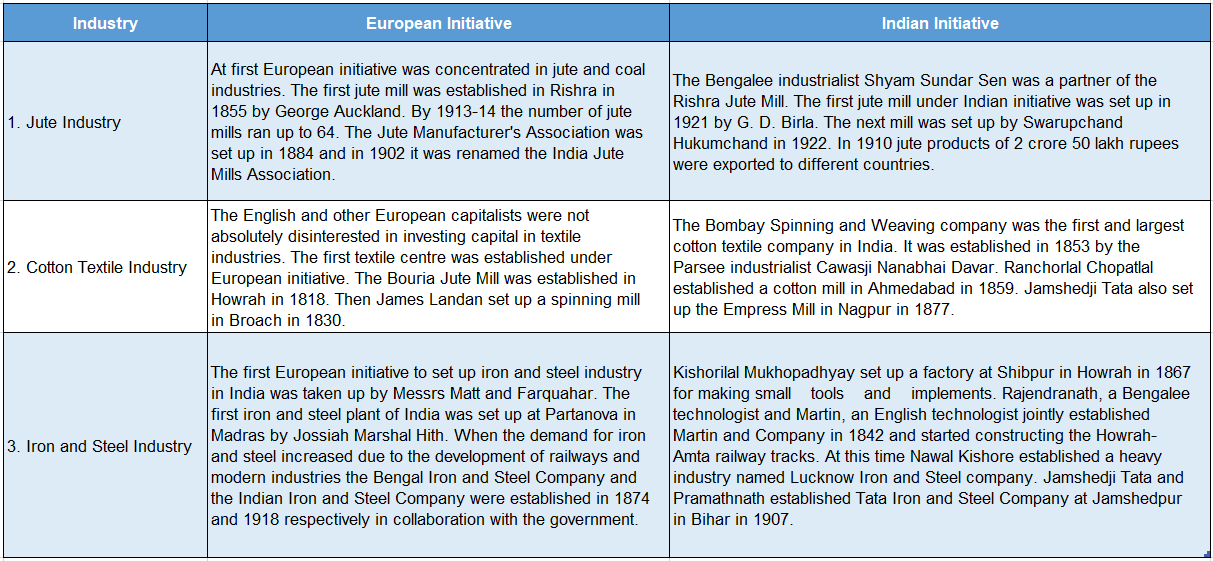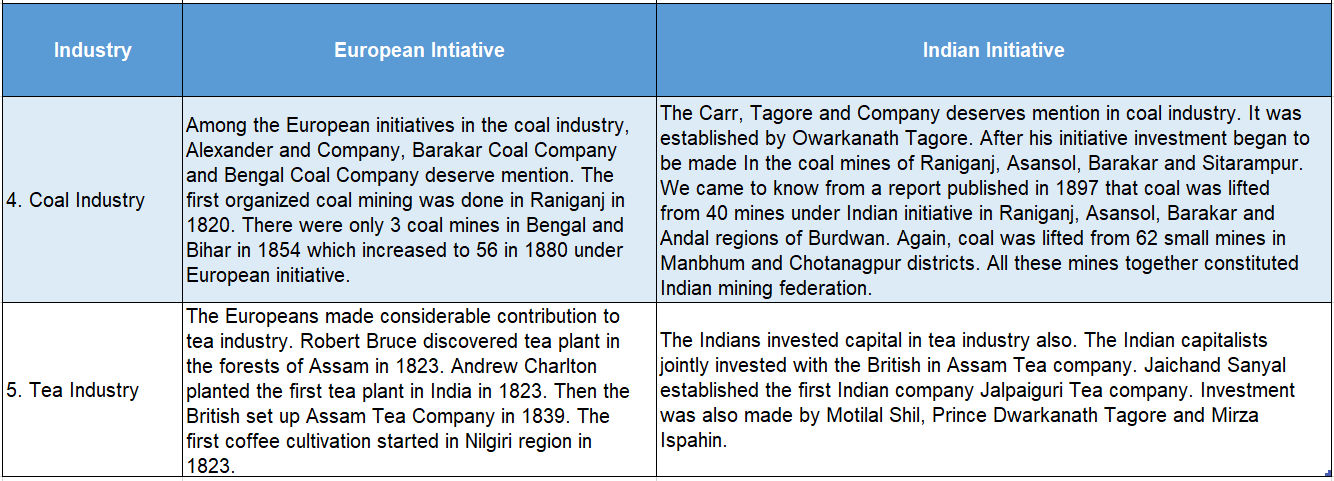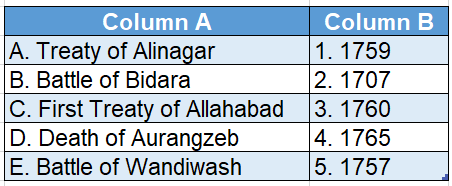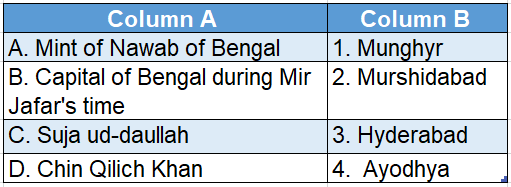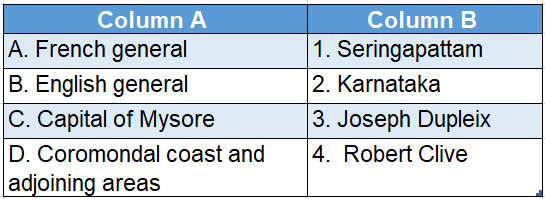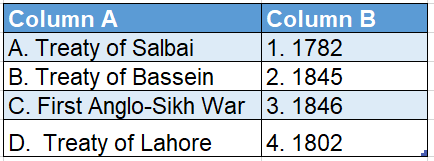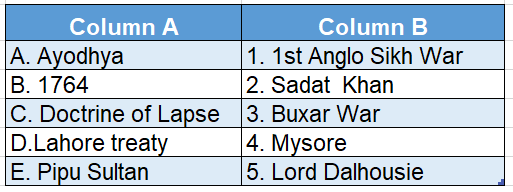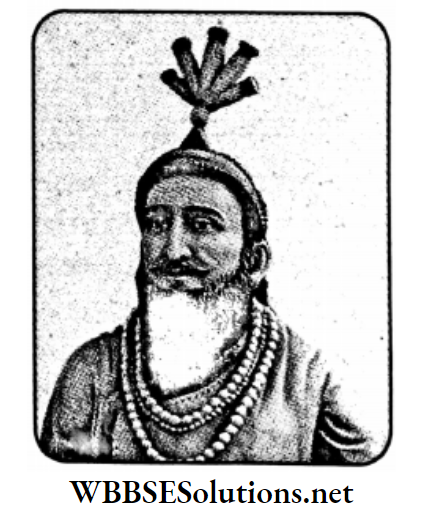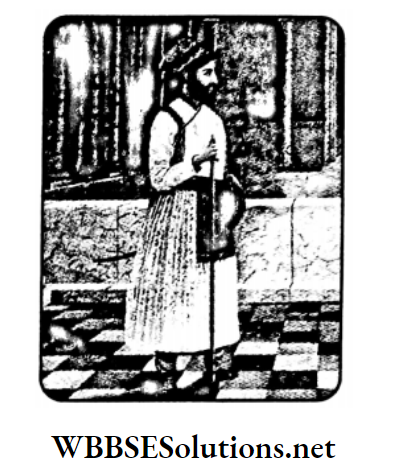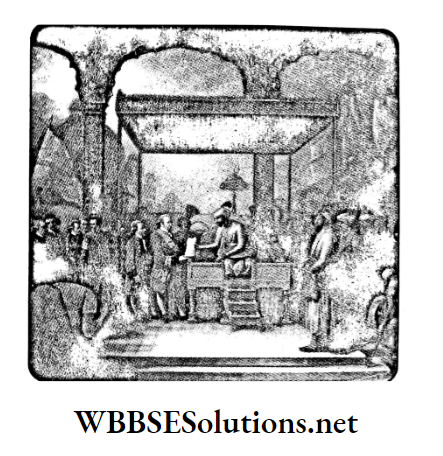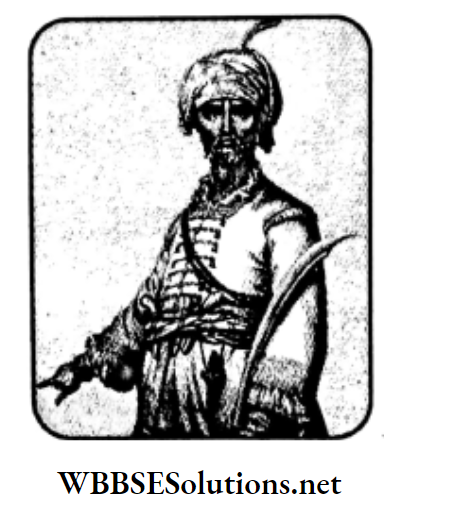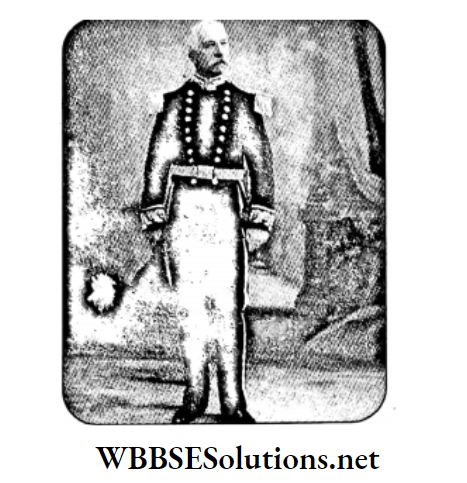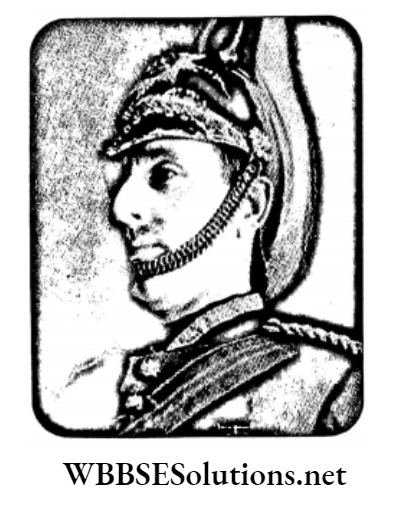Chapter 1 The Idea Of History Salient Points At A Glance
Indian History
The history of India can be traced back to the time of the ancient Harappan civilization. Since then, the stream of history has been continuously flowing till today.
The Indus Valley civilization, the Aryan civilization, the Mauryan Age, the Gupta Age, the Sultanate period and the Mughal period have all been parts of this flowing stream one after the other.
Finally, the British came and established their rule in this country.
India became independent in 1947 and since then India has been playing a significant role in world history.
Class 8 History WBBSE
Nationalism
Nationalism is a kind of feeling through which a nation’s traditions, aspirations, and recollections are manifested. A nationalistic feeling arises when a community begins to feel pleasure, pain, disgrace, or any other sentiment in the context of religion, language, literature, and culture.
This feeling mingled with patriotism constitutes the broader concept of nationalism.
Read and Learn More WBBSE Solutions For Class 8 History
Imperialism
When one country crushes the liberty and sovereignty of another country for self-interest and establishes its domination over that country, it is called imperialism. One country subjugates another with the help of this policy.
Colonialism
Colonialism refers to the policy of occupying land beyond one’s own territory and subsequently establishing political and economic domination over it.
The land thus occupied is called a colony and the colonizing nation derives most of its resources from there.
Gradually it brings the regional residents of the colony under its control and thus begins to enjoy political supremacy apart from economic and commercial monopoly.
Chapter 1 The Idea Of History Descriptive Questions
Question 1. Discuss the chief characteristics of the Modern Age.
Answer:
Modern Age Introduction
The Modern Age began in Europe in 1453 with the fall of Constantinople.
A considerable change could be noticed in the social, political, and economic spheres during this period and these changes became the chief characteristics of the Modern Age.
Chief Characteristics of the Modern Age-
1. Rationalism:
Rationalism is the doctrine in which nothing is taken for granted but everything is scientifically judged by reason. Rationalism began to spread in Europe after the 18th century AD.
2. Rise of capitalism:
A commercial revolution took place in Western countries in the 15th and 16th centuries as a result of geographical discoveries. The merchants began to invest their surplus income in different industries.
As the Indus tries progressed a social system based on capitalism grew up in England and America.
3. Development of industry and trade:
The introduction of highly developed techniques of production and the invention of modern machinery led to an increase in industrial production.
The merchants became rich by selling the finished products.
The geographical discoveries of the 15th and 16th centuries and the invention of instruments like the compass, shuttle, and spinning the wheel facilitated commercial development.
Class 8 History WBBSE
4. Decline of feudalism:
The feudal system began to decline in the 12th century. Many feudal lords were killed in the Crusades or Holy Wars.
As industry and trade expanded the farmers left the manors and sought employment in the growing industries.
All these reasons led to the collapse of the feudal setup.
5. Liberal democracy:
When an administrative system chosen by the people of the state works for the welfare of the people it becomes a liberal democracy.
Such a system developed in England through the Glorious Revolution and the Levellus Movement.
6. Socialism:
The control of production and distribution of income on the basis of the idea of collective ownership rather than personal ownership is called socialism or communism.
The main idea of this doctrine is to establish economic equality among the different classes and groups in society.
Question 2. What is history? How does ancient Indian literature give us an idea of history?
Answer:
Ancient Indian Literature Introduction:
1. Source:
The term ‘History’ has been derived from the Greek word ‘Historia’ and the Latin Word ‘History’.
2. Meaning:
The Greek word ‘Historia’ means to ‘investigate’ and the Latin word ‘History’ means knowledge. Combining the two meanings we can say that history literally means ‘knowledge obtained through investigation.’
History is chiefly concerned with the investigation of the past and takes only significant events into account. In a broad sense history also means investigation, research, discovery, and information.
The Idea of History In Ancient Literature –
1. Mahabharata:
The Indian epic ‘The Mahabharata’ mentions the events of the past, which convey the message of obtaining a perfect life through religion, wealth, lust, and liberation and also provide instructions for the same. These are accepted within the purview of history.
2. Puranas:
According to the Puranas, history is a knowledge that, like a lamp, removes the darkness of illusion from a human mind and illuminates the intellectual realm of a man with the light of truth.
3. Vedic literature:
The Vedic literature includes Puranas, old ballads, stories, folktales, and anecdotes. The stories of ‘Devakiand Shantanu’ and ‘Bishwakarman Bhauban’ of the Nirukti composed by Yask are included in history.
Class 8 History WBBSE
Question 3. Discuss the sources of modern Indian history.
Answer:
Modern India History Introduction
The sources of modern Indian history are no more confined to literary and archaeological elements. Nowadays pictures, photographs, maps, administrative documents, autobiographies, and newspapers are also included among the sources of history.
Sources of Modern Indian History
1. Photographs and maps:
The photographs and maps give us an account of the past as well as contemporary events. The photographs generally provide information about some person, thing, or event. Again, we come to know about some special areas or entire regions from the maps.
Since much information about the social, economic, religious, and political history of a place can be obtained from maps and pictures they are regarded as authentic and important sources of history.
Class 8 History Solution WBBSE
2. Official or administrative documents:
Much historical information can be obtained from official documents. We get an idea of the administrative rules and regulations, agenda, and economic policies from these papers.
Besides, the role, as well as the attitude of the government or the administrative authority, can also be understood by them.
3. Autobiographies:
An autobiography gives information about personal experiences, outlooks, and achievements. the writer as well as about the society to which he belongs.
The various events in the autobiography help us to know about the social and political conditions, beliefs, thoughts, and relationships that existed during that period. However, these are personal accounts and cannot be regarded as dependable sources of history.
4. Newspapers:
Old newspapers are also used as an important source of history. These were published in various languages and contain many events along with photographs. The historians sort out the necessary data from these newspapers.
5. Postage stamp:
Postage stamps are an important resource for the history of modern India. We get an idea of events and personalities from them.
They are quite reliable resources because they present contemporary events clearly. Again, they have higher reliability since they are issued by the government.
Drawbacks:
These sources of modern history are, however, not flawless. Historians have to examine them thoroughly before using them-Sometimes photographs of the same event may be different and this can create confusion.
However, such faults are not found in the case of maps. The views of the author in an autobiography are biased and arbitrary. 3 The official documents are not evaluated properly in all cases.
For instance, the anti-British movements like the Munda or Santhal rebellion and Farazi movements have been marked as disturbances in the official papers of the British government but they are actually parts of a struggle against the colonial powers.
Class 8 History WBBSE
Question 4. Why do we read history?
Answer:
Read History:-
History literally means a record of the past. However, it is an important branch of study and provides a wide scope for an investigation. We need to study this subject for various reasons which are stated below
1. Knowledge of the evolution of man:
History tells us how man has slowly evolved from his primitive, brutish stage to today’s civilized stage.
We not only come to know about the physical changes but also about the gradual development of human intellect over the ages.
2. Helps in the comparative study:
History makes us aware of the different societies, cultures, and civilizations that have flourished through the ages. Therefore, we can compare the different civilizations that developed at the same time.
We can also compare the political, economic, and social systems that exist today with those of the past and calculate the progress of mankind.
3. Links the past with the present:
History arouses a spirit of curiosity and guides us toward the origin of things. The instruments that we use today are only more complicated and modified forms of the simplest tools of the past.
The policies followed by modern governments are, to a large extent, derived from the policies introduced by illustrious kings of the past.
So we automatically try to find out the links between the present and the past.
4. Serves as a lesson:
History tells us about the rise and fall of empires as well as about the responsibilities of the rulers in this context. We learn from the mistakes of our forefathers and refrain from repeating such errors.
At the same time, we receive inspiration from the lives of great personalities from the past and follow their ideals in our own struggles in life.
5. Art, architecture, and literature:
History provides us with elaborate information about the different forms of art that developed in different countries at different ages and are being cultivated today.
We come to know about paintings, sculpture, architecture, clay and metal works, and other crafts that still compel our wonder.
We also learn about different writers and their works from the accounts of history. Thus History provides us with a detailed account of the achievements of different ages.
Class 8 History WBBSE
Question 5. Give an idea of the chronological division or periodization in history.
Answer:
Chronological Division or Periodization Introduction
Indian history, like European history, has been divided into some phases or ages. However, such chronological divisions in India are controversial.
Periodization In Indian History –
1. Ancient Age:
According to some people, the period from the remote past to 1206 constitutes the ancient period in India.
Others think that the period from the remote past to the 6th century AD. till the decline of the Gupta empire is called the ancient period.
The social system was based on chaturanga. During this period the Harappan civilization, the Vedic civilization, and the religious protest movements like Buddhism, Jainism, and Aajivika originated and developed.
Great dynasties like Mauryas, Kushanas, and Guptas ruled over India during this period.
2. Middle Age:
The post-Gupta period the period from the 6th to the middle of the 17th century is referred to as the medieval period or the Middle Ages.
The recent trend is to divide the middle ages into two divisions-early and later middle ages.
Historians like Ram Sharan Sharma, Brajadulal Chattopadhyay, and Nihar Ranjan Roy regard the period from 600 to 1206 as an early medieval period and 1206 to 1757 as a later medieval period.
Some people also regard 1707, the year of Aurangzeb’s death, as the end of the medieval period.
Class 8 History Solution WBBSE
3. Modern Age:
The Modern Age began in 1757 (1707 according to some) and is still continuing. The Europeans started coming to India during this period.
Taking advantage of the weakness of the Mughal Empire the British East India Company gradually established its power in India.
Afterward, the reins of the government went directly into the hands of the Crown, i.e., the Queen of England. Then the struggle for freedom began.
On August 15, 1947, India got independence but became divided into two separate states-India and Pakistan. Now India’s onward march as an independent republic began.
Class 8 History WBBSE
Question 6. How did James Mill make the chronological division of Indian history on a communal basis? Why was such periodization objectionable?
Answer:
Mills Periodisation
The British historian James Mill has divided the history of India into Hindu, Muslim, and British eras.
His main intention was to prove that the British period was much more progressive in comparison to the earlier periods and there was considerable development in the social, political, and economic spheres.
According to James MIII, the time from the primitive age to 1206 is termed the Hindu Era, the time from 1206 to 1707, till the death of Mughal emperor Aurangzeb is called the Muslim Era, and the period following 1707, is referred to as the British Era.
Reasons For Objection –
1. Importance of other religions in the so-called Hindu era:
It is not that in the so-called Hindu era, only Vedic Hinduism was prevalent and only Hindu kings ruled. In this period we come across the glorious reins of Jain rulers like Chandragupta Maurya and Buddhist rulers like Ashoka and Kaniskha.
Since the ages Hinduism has undergone a number of changes, many foreign rulers following some other religion had ruled, and Buddhism and Jainism have become much more popular. So we should call this period, the ‘ancient age’ rather than the ‘Hindu era’.
2. Importance of other religions in the so-called Muslim era:
Similarly the term ‘Muslim era’ is not justified. In this age, many Hindu kings and kingdoms co-existed with the Muslim kingdoms.
For example, the kingdoms of Orissa, Rajputana, Madhya Pradesh, Assam, Chotanagpur, Kerala, and Vijaynagar in Deccan had been continuously resisting Muslim invasions and could maintain their independent existence with full prestige and glory.
Class 8 History Solution WBBSE
Question 7. Discuss the work of historians.
Answer:
Work of Historians Introduction
In modern research on the history, there is a controversy over the work of historians. Their main task is to present data and analyze them.
Work Of Historians-
Data Presentation:
1. Supporters:
Modern historians like Rankeand Markblokh think that the task of the historian is to present data.
2. Opinions:
View of Ranke:
Ranke thinks that the main task of a historian is to present data honestly and impartially. They cannot impose their biased interpretation of data on the readers.
So they must present the data honestly before the readers and the readers would interpret them by themselves.
View of Mark Bloch:
Mark Bloch also thought that historians should only present data and not interpret them. A historian would transgress his limits if he tries to analyze them. This is because a historian is not a judge and has no right to judge the incidents of the past.
Data Analysis
1. Supporters:
The supporters of this theory modern age. Significance of massive Thucydides and Berkley.
2. Opinions:
View of Thucydides:
According to the Greek historian Thucydides, historians are responsible to society and so they should be absolutely truthful.
The historian ought to be given the right to interpret data so that he can fulfill his duties toward society.
View of Berkley:
Berkley compared the earlier and later events and showed their similarities by analyzing the social events.
According to him the task of the historian is to analyze social trends. Simple data collection is only a cut-and-paste method.
Question 8. Focus on the periodization in European history.
Answer:
Periodization in European History Introduction
Periodization chronological division is an important part of history. The history of any country is generally divided into ancient age, middle age, and modern age.
Periodisation In Europe
In the European history
Ancient Age:
The period from times immemorial to 476 AD is referred to as the Ancient Age,
Middle Age:
The period from the dethroning of the Roman emperor Romulus by the German general Odoacer in 476 to the fall of Constantinople in 1453 is termed the Middle Age and
Modern Age:
The period from 1453 is continuing as the Modern Age.
Dispute over periodization:
There is much dispute among historians regarding the periodization of European history,
Dispute over the termination of the middle ages:
Some scholars regard 1453, the time of the fall of Constantinople (the capital of the Eastern Roman Empire) as the termination point of the middle ages and the starting point of the modern age.
Others regard 1492 when America was discovered or the time of the Reformation in Europe in the 16th century to be the end of the middle ages and the beginning of the modern age
Significance of massive the transformation in periodization:
We must remember that periodization is done after noticing particular changes in the thought processes and concepts of man.
The chief features of the modern age are the elimination of feudalism and serfdom.
From this point of view, the medieval period still prevailed in some European countries. Feudalism was uprooted in France in 1789 when the French Revolution took place. The serfdom in Prussia was eradicated at the beginning of the 19th century.
In Russia, it ended in 1861. Again, the middle ages lingered longer in Asia than in Europe.
Class 8 History Solution WBBSE
Question 9. What is imperialism? How did British imperialism begin in India?
Answer:
Imperialism
Imperialism is a policy by which a country or a nation extends its empire by occupying other countries and establishing its supremacy over those lands and the people living there.
Beginning of British Imperialism in India
Through the European traders entering India for commercial purposes, they took advantage of the weakness of the later Mughals, the absence of a central administration, and political chaos and tried to establish their colonies here.
The English defeated Siraj ud-daullah in the Battle of Plassey in 1757 and the combined forces of Mir Qasim (the Nawab of Bengal), Sujah-ud-daulah (the Nawab of Oudh), and the Mughal Emperor Shah Alam II in the Battle of Buxar in 1764.
The British East India Company established its domination not only in Bengal, Bihar, and Orissa but also in Ayodhya and Delhi.
They also defeated two more colonial powers-the French in the Third Carnatic War (1756-63) and the Dutch in the Battle of Bidara (1759).
Then they occupied Mysore (1799) Ayodhya (1856) and other kingdoms and thus extended their empire. By 1857, almost the whole of India came under British rule.
Question 10. What were the reasons behind the establishment of colonies?
Answer:
Establishment of Colonies Introduction
Whenever any country occupies the territory of another country, then these areas are referred to as colonies. The more powerful countries set up their colonies in the comparatively weaker countries due to various reasons.
Reasons Behind Colonization –
1. Aspiration for power:
The European countries tried to become more resourceful by conquering lands with economic riches.
Countries like England, France, Spain, and Portugal began to colonize different countries with the aim of establishing commercial and military power.
2. Surplus capital:
The capitalist groups began to pressurize their respective governments for colonization.
The swelling of capital indirectly created the background for the rise of colonialism. The Industrial Revolution and the emergence of capitalism aided the process.
3. Development of capitalism:
The importance of a capitalistic economy increased due to the Industrial Revolution which spread all over Europe.
More and more investors began to be made in the industries both within the country and abroad. So colonization was necessary for the development of capitalism.
4. Endeavour to increase military power:
The colonizers often formed armies with the residents of the occupied areas.
Again, an army was also necessary to administer the colonies properly. So the desire to increase military power encouraged colonization.
5. Import-export:
The industrialized nations began to look for colonies to import necessary raw materials and export finished products.
Question 11. What were the motives behind imperialism?
Answer:
Imperialism Introduction
Imperialism refers to the policy of extending a country’s empire by occupying other territories and establishing its supremacy there.
Motives-
1. Economic resources:
In the ancient period, Rome tried to establish its empire over the Mediterranean region to profit from the trade. Later on, Naval powers like England, France, Spain, and Portugal followed the imperialistic policy to import raw materials for their industries and to export finished products.
2. Development of nationalism:
One nation may feel self-satisfaction by establishing linguistic and cultural domination over another country.
Again, a ruler might build a vast empire to prove his valor. Again, imperialism may also arise from an attempt to increase national power.
3. National security:
Sometimes some countries try to extend their frontiers in the plea of ensuring the safety of their nations. With this purpose, they bring other countries under their domination.
4. Rehabilitation of population:
As the population of a country increases, it tries to Occupy other territories in order to rehabilitate its people.
Countries like Germany, Japan, and Italy carried on their imperialistic policies under such pretexts.
5. Spread the ideals of religion and civilization:
Since ancient times the European Jesuits and Christian priests went to unknown lands to spread Christianity and other ideals of European civilization.
Later on, the merchants and political leaders followed them and carried on their imperialistic policies.
Question 12. How did the British government create racial differences by virtue of colonial rule?
Answer:
Colonial Rule Introduction
The British ruled over the Indians who were dark-complexioned people. The Britishers tried to utilize this racial difference as well as the existing caste discrimination to consolidate their colonial rule.
Racial Discrimination In British India –
1. In administration:
The Indian officials were deliberately humiliated in public.
This racial discrimination became quite common in all departments of the government. The British even preached racial discrimination or discriminatory ideas openly.
2. In the judicial system:
Separate courts were set up to judge the dark-skinned Indians but they were completely dominated by white people.
The British government used these colonial courts to serve its own interests. The white people were acquitted with a minimum fine.
3. In the economic sphere:
Racial discrimination could be most poignantly felt in the economic sphere.
The white people always got more facilities in trade and commerce than the Indians. They also formed their own trade associations and unions.
They organized associations related to jute, tea, and minerals which served their interests. The main intention of the British was to make the Indians economically weak.
Class 8 WBBSE History Question Answer
4. In the social sphere:
Reservation:
Seats were reserved for the Europeans in railway waiting rooms, parks, clubs, steamers, and hotels.
If a European occupied a compartment in a train, then no Indian was allowed to enter it in spite of possessing a valid ticket.
Humiliation:
Ordinary Indian citizens as well as eminent Indian personalities were insulted by the British every now and then and they could never seek redress.
No Indian could ride on a horse or an elephant or travel in a palanquin in front of the British officers.
Even Raja Rammohan Roy was taken to task for traveling in a palanquin. Ishwar Chandra Vidyasagar was not allowed to enter the Calcutta Museum wearing slippers.
Question 13. What were the reasons for the rise of nationalism in India?
Answer:
Nationalism Introduction
The period from 1858 was the development of nationalism in India.
1885 is generally regarded as the period of increasing exploitation and oppression on the part of British imperialism led to the emergence and development of nationalism in India.
Reasons for the Rise of Indian Nationalism-
1. Clash of mutual interest:
The main reason for the rise of Indian nationalism was the clash of interests between the British government and the Indians.
When the British government deprived the Indians of their due rights and prestige, nationalistic feelings grew up among the Indians.
2. Racial malice:
The British people regarded themselves to be racially superior to the Indians. They always detested and neglected the dark-complexioned Indians.
This arrogant and discriminatory behavior of the white people aroused nationalistic sentiment among the Indians.
3. Economic exploitation:
The British carried on continuous economic exploitation after winning the Battle of Plassey. The Indian economy collapsed due to the despotic land revenue system, the excessive burden of taxes, and the destruction of indigenous industries. All these led to the emergence of nationalistic feelings.
4. Oppressive laws and policies:
The Subsidiary Alliance of Wellesley, Dalhousie’s Doctrine of Lapse, the Jury Act of Amherst, the Pitt’s India Act, the Municipality Act of Curzon, the Dramatic Performance Restriction Act of Northbrook, the Vernacular Press Act and Arms Act of Lytton helped to spark nationalistic ideals among the Indians.
Question 14. What were the reasons behind the peasant and tribal revolts in the first decade of British rule?
Answer:
Tribal Rovolts Introduction
Several peasant and tribal uprisings took place against British rule and the exploitation carried out by them. The discriminatory policies followed by the British after 1757 struck the interests of the peasants and the tribals adversely. This led to successive revolts by the peasants and the tribals.
Reasons Behind Peasant And Tribal Revolts
1. High rate of revenue:
The British began to extract huge revenue from the peasants after receiving ‘Diwani’ in 1765 to increase their wealth. This made it difficult for the peasants to maintain their existence.
2. Exploitations by Zamindars and Officials:
As the Zamindars and English officials collected rent and revenue from the peasants forcibly they were compelled to take loans from the money lenders at a high rate of interest. In this way, they got entrapped in a vicious web of debt and became bankrupt.
3. Evil result of the land reforms:
As a result of the introduction of the permanent settlement, Ryotwari system, and Mahulwari system the company officials, Zamindars, landlords and leaseholders forcibly collected revenue and evicted the farmers from their lands.
4. Compulsion to grow cash crops:
The peasants and tribals rose in revolt when they were forced to grow cash crops like indigo, tea, jute, cotton, and rubber instead of food crops to ensure the supply of raw materials for the industries.
5. Seizure of the rights of the tribals:
The tribals usually lived in forested areas and carried on cultivation by clearing forests. When the company’s rule was established all over India the rate of revenue collected from the tribal regions was raised.
Their prevalent social system, judicial system, and economy also collapsed. So they rose into revolt to express their grievances
Class 8 WBBSE History Question Answer
Chapter 1 The Idea Of History Short Analytical Questions
Question 1. Discuss the views of Rabindranath and Bankim Chandra on ‘The History of India’.
Answer:
Rabindranath’s View on Indian History:
According to Rabindranath Tagore, the story of Indian history is a ‘nightmare’. It is the story of bitter and fatal fights between father and son or brothers over the accession to the throne.
This nightmare became more complicated with the arrival of the Pathans, Mughals, Portuguese, French, and English. Rabindranath thinks that the actual essence of India cannot be seen through the thick curtain .of this blood-smeared nightmare. So this history is not really the history of the Indians.
Bankim Chandra’s view of Indian history:
Bankim Chandra Chattopadhyay also felt the need for a proper historical account. He has said, “We need the history of the Bengalees. The Bengalees must know their own past or there is no way out.
” He thought that the foreigners’ account of Bengal is erroneous and so the Bengalees must reconstruct their own history.
So he invited all Bengalees to join hands together in this task.
Ashim Dasgupta has written in the context of Bankim Chandra’s awareness of history “History occupied a special place in Bankim’s thoughts.
He had tried to create awareness of history. Historical knowledge and such historical awareness are quite different”.
Arguments Against:
There are mental differences between history and science.
Science arrives at a definite conclusion after much observation and experiment but there is no such scope for experiments in history.
Again, science can hint towards the future but history cannot. Therefore, history is not pure science. We can rather call it a social science.
Question 2. Can we regard history as a science?
Answer:
Arguments for and against regarding history as a science
There is a controversy as to whether history can be regarded as a science. Darwin was the first person to accept history as a science.
Arguments For:
Just as in the case of modern scientific research, emphasis is given to data collection in the case of historical studies also.
Again, archaeologists use scientific methods and apparatus to examine the relics. Therefore, we can regard history as a science.
Arguments Against:
There are fundamental differences between history and science.
Science arrives at a definite conclusion after much observation and experiment but there is no such scope for experiments in history.
Again, science can hint towards the future but history cannot. Therefore, history is not a pure science, we can rather call it a social science.
Question 3. Why is there a lack of historical studies in India?
Answer:
Ancient Age:
We do not get many written accounts of the history of the Ancient Age. There were no detached historians except Kalhan.
He had advised historians to give up emotions and prejudices and write accurately and impartially. Unfortunately, this ideal was missing in the historical works of the subsequent ages.
Medieval Age:
In medieval India only a few historians like Zia-ud-din Barni could write history accurately and impartially.
Modern Age:
Most modern historians could not shake off the British influence and, therefore, failed to write history impartially.
Thus the non-availability of reliable accounts has weakened the propensity for studying history in India.
Class 8 WBBSE History Question Answer
Question 4. How was the foundation of British rule laid in India?
Answer:
Foundation Of British Rule Laid In India:-
1. Dastak or permission for free trade:
The British East India Company had come to India for trade purposes. In 1717 they obtained ‘data’ or passes for free trade from the Mughal emperor Farrukhsiyar.
2. Victory in the Battles of Plassey and Buxar:
The British established their domination in India after defeating Siraj ud-daullah, the Nawab of Bengal, in the Battle of Plassey (1757) and Mir Qasim in the Battle of Buxar.
3. Grant of Diwani:
The British East India Company received the Diwani or the right to collect revenue in 1765 and laid the foundation of British imperialism in India.
Question 5. How did Mrityunjay Vidyalankar make the periodization of Indian history at the beginning of the 19th century?
Answer:
Mrityunjay Vidyalankar Make The Periodization Of Indian History At The Beginning Of The 19th Century As Follows :-
Mrityunjay Vidyalankar was a member of the literary committee of Fort William College. He wrote a book on history named ‘Rajabali’ in 1808. In this book, he has mentioned the different ages of Indian history.
According to him, the history of India begins with the reign of King Yudhishtira of Mahabharata. In this book, he described the establishment of the company’s rule in Bengal.
Question 6. How did Bankim Chandra make a periodization of the history of Bengal?
Answer:
Bankim Chandra Make A Periodization Of The History Of Bengal:-
The eminent Bengali litterateur Bankim Chandra Chattopadhyay wanted to write the history of Bengal but ultimately could not do so. However, he divided the history of Bengal into some phases
- The period till the conquest by the Turks,
- The period till the conquest by the Mughals,
- The period till the victory of the English and
- The period following the English victory.
Bankim Chandra has written separate novels with the backdrop of each of these phases. For example, he wrote ‘Mrinalini’ on the backdrop of the Turkish conquest, ‘Durgesnandini’ on the backdrop of the Mughal conquest, ‘Sitaram’ on the downfall of the Mughals, and ‘Anandamath’ on the English conquest.
Question 7. Mention some of the significant events of modern Indian history.
Answer:
Some Of The Significant Events Of Modern Indian History:-
Some significant events of history and amassed the wealth of their respective of modern India are as follows
1. Battle of Plassey:
The Battle of Plassey took place between Siraj ud-daullah, the Nawab of Bengal, and the British East India Company in 1757.
2. Grant of Diwani:
The East India Company got the ‘Diwani’ or the right to collect revenue from the states of Bengal, Bihar, and Orissa in 1765.
3. Sepoy Mutiny:
The Indian soldiers rose in Ans. rebellion against the British in 1857.
4. Non-violent movements under the leadership of Gandhiji:
The mass movements led by Gandhiji were Noncooperation Movement (1920), the Civil Disobedience Movement (1930) and Quit India Movement (1942).
5. India’s independence:
Indiaindependent on August 15, 1947.
Class 8 WBBSE History Question Answer
Question 8. How pathetic and agonizing was the memory of the partition of the country?
Answer:
Pathetic And Agonizing Was The Memory Of The Partition Of The Country:-
Partition of the country brought a great crisis to the nation.
Cruel fratricidal riots, plunder, and persecution of women began in both parts of Punjab and Bengal. Massacres led to the loss of many lives and many people became homeless.
Partition of land, food crisis, unemployment, and refugee problems made the situation of the Indians really pathetic and agonizing.
Question 9. What is the significance of imperialism?
Answer:
Significance Of Imperialism:-
The rise of imperialism was a significant event in world history.
First, the European countries expanded their culture and civilization over the countries of Asia, Africa, and Latin America by following an imperialistic tendency.
Second, imperialism arose out of the intention of reaping benefits through economic exploitation.
The European countries exploited and amassed the wealth of their respective colonies.
They also imported raw materials from and exported finished products to these colonies
Third, the European countries came into conflict with each other while extending their empire through colonialism.
The conflict between Japan and Russia took place when Japan advanced to check Russian aggression.
Question 10. What is meant by colonialism?
Answer:
Colonialism:-
1. Meaning:
The term ‘colony’ comes from the word ‘colonialism’, which has again been derived from the Latin word ‘colonial’ which implies a huge property or estate.
2. Definition:
it is generally said that if any country occupies land or a region and establishes its domination there then that region is called a colony.
The encyclopedia of social science says colonialism means the establishment of a country’s domination over the geographical area of another land and then gradually bringing its economy, politics, culture, and civilization under its own control.
Question 11. Focus on the recent dispute regarding the periodization of Indian history.
Answer:
The Recent Dispute Regarding The Periodization Of Indian History:-
1. Dispute:
There is a dispute over extending the time limit of the ancient period to 1206.
Some people think that the period from 606 (death of Harshavardhana) to 1206 should be regarded as the early medieval period.
A new political era was ushered in after Harshavardhana’s death.
The social unity was destroyed and separate kingdoms were set up by the Pratiharas in north and west India, the Palas in east India, the Rashtrakutas in the Deccan, and the Cholas in the far south.
The Tripartite struggle between the Palas, the Pratiharas, and the Rashtrakutas continued for two hundred years.
Revolutionary changes also took place in the social, cultural, and economic spheres. So this sort of age division or periodization is not unanimous.
2. Conclusion:
Anyway, the period from 1206 to 1707 is called the medieval period and the period following 1707 is called the modern period in Indian history.
Class 8 WBBSE History Question Answer
Chapter 1 The Idea Of History State Whether The Following Statements Are True Or False
Question 1. Rabindranath felt that those countries who find their names in history are fortunate.
Answer: True
Question 2. Bankim Chandra Chattopadhyay said, “We want the history of the Bengalees.”
Answer: True
Question 3. The Battle of Plassey took place before the Kalinga War.
Answer: False
Question 4. The term ‘adhunik’ (modern) has come from the word ‘sadhana’.
Answer: True
Question 5. The Kalinga War took place after the Battle of Panipat.
Answer: False
Question 6. Indian history became more modern with the passage of time after 1757.
Answer: True
Question 7. James Mill has divided the history of India into three ages-Hindu, Muslim and British.
Answer: True
Question 8. Subhas Chandra Bose was elected president of the Haripura Congress in 1938.
Answer: True
Chapter 1 The Idea Of History Fill In The Blanks By Selecting The Appropriate Expressions From The Brackets
Question 1. ______(Literature/ History/Politics) is not merely the names of kings and emperors, dates and descriptions of wars.
Chandra
Answer: History
Question 2. ________ (Rabindranath Tagore/Bankim Chattopadhyay/Mrityunjay Vidyalankar) has said, ‘The history of Bengalees written by foreigners is erroneous’.
Answer: Bankim Chattopadhyay
Question 3. ‘Rajabali’ was written by ________ (Bankim MrityunjayChandra Chattopadhyay/ Vidyalankar/ Rabindranath Tagore).
Answer: Mrityunjay Vidyalankar
Question 4. ‘History of British India’ was written by ________ (Vincent Smith/ James Mill/Alexander Cunningham).
Answer: James Mill
Question 5. The Battle of Plassey took place between Siraj ud-daullah ________ (Siraj ud-daullah/Mir Jafar / MiradQasim) and the British.
Answer: Siraj ud-Abdallah
Question 6. The Battle of _______ (Kalinga/Panipat/ Haldighat) exerted much influence on the life of the Mauryan emperor Ashoka.
Answer: Kalinga
Question 7. ‘Nil Darpan’ was written by ________ Michael Madhushudan Dutta/Dinobandhu Mitra/ Bankim Chandra Chattopadhyay).
Answer: Dinobandhu Mitra
Question 8. Sidhu and Kanhu were the two leaders of the ________ (Shel/Munda/Santhal) rebellion.
Answer: Santhal
Class 8 WBBSE History Question Answer
Chapter 1 The Idea Of History Answer In A Complete Sentence
Question 1. Who divided Indian history into three periods-Hindu, Muslim and British?
Answer: James Mill divided Indian history into three periods-Hindu, Muslim and British
Question 2. What is imperialism?
Answer: Imperialism is a process by which a stronger country subjugates a weaker country.
Question 3. “You and I and everyone together will write our own history”–Who said this?
Answer: Bankim Chandra Chattopadhyay said this.
Question 4. Who is the biographer of Allan Octavian Hume?
Answer: William Wedderburn is the biographer of Allan Octavian Hume.
Chapter 1 The Idea Of History Select The Most Appropriate Option For The Following Statement
Question 1. Bankim Chandra said, “We want the history of the Bengalees.”
- The Bengalees should know their own past.
- The history of Bengal is a national asset.
- The progress of the Bengalees is associated with it.
Answer: 1. The Bengalees should know their own past.
Question 2. Reading history is an amusing thing.
- History contains many amusing topics.
- There are debates in history regarding events and their consequences.
- There are many funny stories in history.
Answer: 2. There are debates in history regarding events and their consequences.
Question 3. In the context of time, the Battle of Plassey is quite modern in comparison to the Battle of Panipat.
- The Battle of Panipat took place in the ancient period and the Battle of Plassey took place in the modern period.
- The Battle of Panipat took place much later than the Battle of Plassey.
- The Battle of Plassey took place much later than the Battle of Panipat.
Answer: 2. The Battle of Panipat took place much later than the Battle of Plassey.
Question 4. The photographs are an important source of the history of modern India.
- The photographs present the claims of the past.
- We come to know about the social, economic, and political history from the photographs.
- They contain pictures of political leaders.
Answer: 2. We come to know about social, economic, and political history from the photographs.
Question 5. Titu Mir, Birsa Munda, and Sidhu-Kanhu were not anarchists.
- As anti-colonists, they were actually freedom fighters.
- They were the leaders of tribal revolts.
- They were the symbols of the hopes and aspirations of the tribal people.
Answer: 1. As anti-colonists they were actually freedom fighters.
Class 8 WBBSE History Question Answer
Chapter 1 The Idea Of History Strike The Odd One Out
Question 1. King, Emperor, Badshah, Prime Minister
Answer: Prime Minister
Question 2. Portuguese, French, Guptas, British
Answer: Guptas
Question 3. Imperialism, C, Colonialism, Nationalism
Answer: Marxism
Question 4. Mrityunjay Vidyalankar, Rabindranath Tagore, Bankim Chandra Chattopadhyay, James Mill
Answer: James Mill
Question 5. Noor Jahan, Raziya, Nefertiti,Rani Durgawati
Answer: Nefertiti
Question 6. Ashoka, Iltutmish, Akbar, Napoleon
Answer: Napoleon
Question 7. Newton, Aryabhatta, Varahamihir, Brahmagupta
Answer: Newton
Question 8. Sri Chaitanyadeva, Jesus Christ, Gautama Buddha, Guru Nanak
Answer: Jesus Christ
Question 9. Mahatma Gandhi, Mountbatten, Subhas Chandra Bose, Jawaharlal Nehru
Answer: Mountbatten
Question 10. Spartacus, Titu Mir, Birsa Munda, Sidhu
Answer: Spartacus
Chapter 1 The Idea Of History Match The Columns

Answer: A-4,B-3,C-1,D-2

Answer: A-2,B-1,C-3,D-4

Answer: A-3,B-4,C-1,D-2
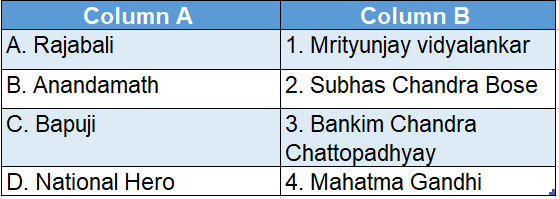
Answer: A-1,B-3,C-4,D-2
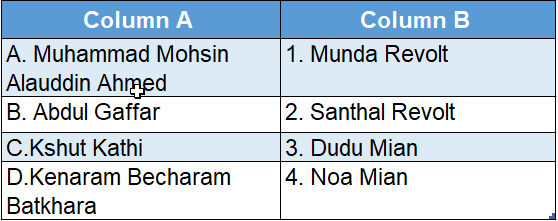
Answer: A-3,B-4,C-1,D-2
Chapter 1 The Idea Of History Multiple Choice Questions
Question 1. “The history of our country has prevented us from learning about our homeland”- Who said this?
- Bankim Chandra Chattopadhyay
- Rabindranath Tagore
- Swami Vivekananda
- James Mill
Answer: 2. Rabindranath Tagore
Question 2. Mrityunjay Vidyalankar wrote ‘Rajabali’ in
- 1757
- 1799
- 1808
- 1857
Answer: 3. 1808
Question 3. Aurangzeb died in
- 1707
- 1777
- 1800
- 1857
Answer: 3. 1800
Question 4. Who wrote that the Muslim period was the dark age of Indian history?
- Jeremy Bentham
- Jadunath Bose
- James Mill
- Dinabandu Mitra
Answer: 1. Jeremy Bentham
Question 5. Razia became sultan of Delhi after
- lltutmish
- Ghiyasuddin Balban
- Alauddin Khilji
- Mohammad bin Tughlaq
Answer: 1. lltutmish
